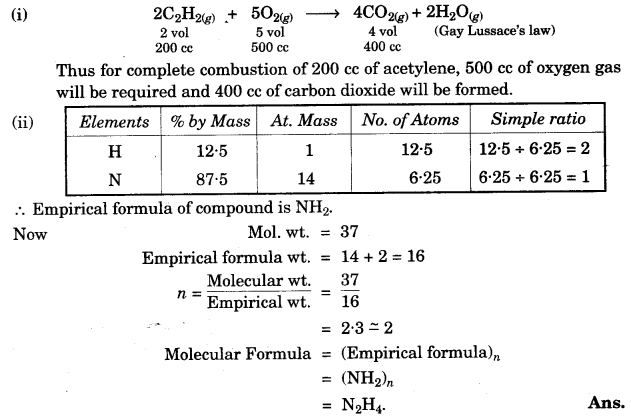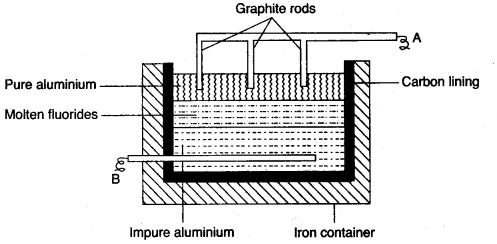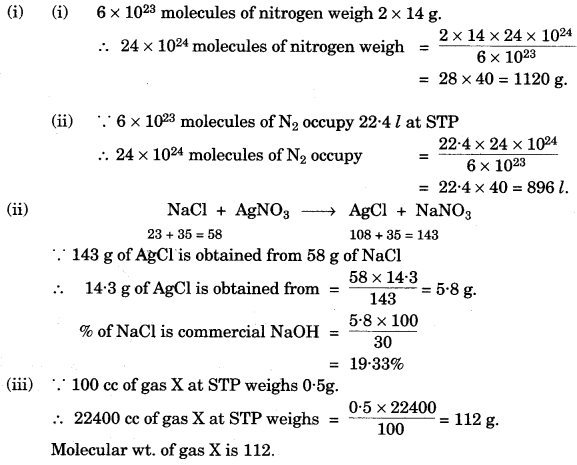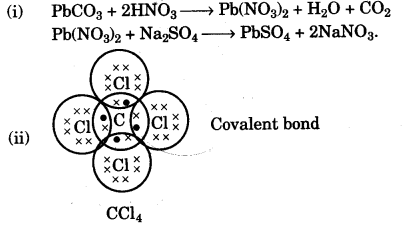ICSE Chemistry Previous Year Question Paper 2009 Solved for Class 10
ICSE Paper 2009
CHEMISTRY
(Two Hours)
Answers to this Paper must be written on the paper provided separately.
You will not be allowed to write during the first 15 minutes.
This time is to be spent in reading the Question Paper.
The time given at the head of this Paper is the time allowed for writing the answers.
Section I is compulsory. Attempt any four questions from Section II.
The intended marks for questions or parts of questions are given in brackets [ ].
SECTION-I (40 Marks)
(Attempt all questions from this Section)
Question 1:
(a) Name the gas evolved in each case (formula is not acceptable).
- The gas produced by the action of concentrated sulphuric acid on sodium chloride.
- The gas produced by the action of dilute nitric acid on copper.
- The gas produced on heating sodium nitrate.
- The gas that burns in oxygen with a green flame.
- The gas that can be oxidised to sulphur. [5]
(b) Match the substance A to E listed below with the appropriate description in parts (1) to (5)
(A) Sulphur (B) Silver chloride (C) Hydrogen chloride (D) Copper (II) sulphate (E) Graphite.
- A non-metal which is a good conductor of electricity.
- A covalent compound which behaves like an ionic compound in aqueous solution.
- A compound which is insoluble in cold water but soluble in excess of ammonia solution.
- A pink metal which is deposited at the cathode during the electrolysis of the solution of this salt.
- A non-metal which reacts with concentrated nitric acid to form its own acid as one of the product. [5]
(c) For part (c). 1 – (c). 10, select the correct answer from the choices A, B, C and D which are given.
Write only the letter corresponding to the correct answer. [10]
- Among the period 2 elements the one which has high electron affinity is:
(A) Lithium (B) Carbon
(C) Fluorine (D) Neon - Among the following the one which is composed, of all the three kinds of bond (ionic, covalent and coordinate bond) is:
(A) Sodium chloride (B) Ammonia
(C) Carbon tetrachloride (D) Ammonium chloride - Which of the following statements is wrong about alkanes?
(A) They are all saturated hydrocarbon.
(B) They can undergo addition as well as substitution reaction.
(C) They are almost non polar in nature.
(D) On complete combustion give out carbon dioxide and water. - Select the acid which contains four hydrogen atoms in it.
(A) Formic acid (B) Sulphuric acid
(C) Nitric acid (D) Acetic acid - A gas cylinder of capacity of 20 dm3 is filled with gas X the mass of which is 10 g. When the same cylinder is filled with hydrogen gas at the same temperature and pressure the mass of the hydrogen is 2 g, hence the relative molecular mass of the gas is:
(A) 5 (B) 10
(C) 15 (D) 20 - The aqueous solution of the following compounds which contains both ions and molecules is:
(A) Sulphuric acid (B) Hydrochloric acid
(C) Nitric acid (D) Acetic acid - The metal oxide which can react with acid as well as alkali is:
(A) Silver oxide (B) Copper (II) oxide
(C) Aluminium oxide (D) Calcium oxide - Carbon dioxide and sulphur dioxide gas can be distinguished by using:
(A) Moist blue litmus paper
(B) Lime water
(C) Acidified potassium dichromate paper
(D) None of the above. - The organic compound obtained as the end product of the fermentation of sugar solution is:
(A) Methanol (B) Ethanol
(C) Ethane (D) Methanoic acid - A black colour solid which on reaction with dilute sulphuric acid forms a blue coloured solution is:
(A) Carbon (B) Manganese (TV) oxide
(C) Lead (II) oxide (D) Copper (II) oxide
(d) Write a fully balanced equation for each of the following cases: [5]
(i) Red lead is warmed with concentrated hydrochloric acid.
(ii) Magnesium metal is treated with dilute hydrochloric acid.
(iii) Lead nitrate is heated in a dry test tube.**
(iv) Magnesium nitride is treated with warm water.
(v) Acetic acid is warmed with ethanol in the presence of concentrated sulphuric acid.
** Answer has not given due to out of present syllabus.
(e) Find the odd one out and explain your choice (note: valency is not a criterion) [5]
- Al(OH)3, Pb(OH)2, Mg(OH)2, Zn(OH)2
- C3H8, C5H10 C2H6 & CH4
- Sulphur, Phosphorus, Carbon, Iodine
- Copper, Lead, Zinc, Mercury
- Formic acid, Nitric acid, Acetic acid, Propanoic acid.
(f) Identify the substances, P, Q, R, S and T in each case based on the information given below: [5]
- The deliquescent salt P, turns yellow on dissolving in water, and gives a reddish brown precipitate with sodium hydroxide solution.
- The white crystalline solid Q is soluble in water. It liberates a pungent smelling gas when heated with sodium hydroxide solution.
- The pale green solid R turns reddish brown on heating. Its aqueous solution gives a white precipitate with barium chloride solution. The precipitate is insoluble in mineral acids.
- The reddish brown liquid S is dissolved in water. When Ethyne gas is passed through it, turns colourless.
- The nitrate T does not leave any residue on heating. **
** Answer has not given due to out of present syllabus.
(g) (i) Calcium carbide is used for the artificial ripening of fruits. Actually the fruit ripens because of the heat evolved while calcium carbide reacts with moisture. During this reaction calcium hydroxide and acetylene gas is formed. If 200 cm3 of acetylene is formed from a certain mass of calcium carbide, find the volume of oxygen required and carbon dioxide formed during the complete combustion. The combustion reaction can be represented as below:
2C2H2(g) + 5O2(g) → 4CO2(g) + 2H2O(g)
(ii) A gaseous compound of nitrogen and hydrogen contains 12.5% hydrogen by mass. Find the molecular formula of the compound if its relative molecular mass is 37.
[N =14, H = 1] [5]
Answer:
(a)
- Hydrogen chloride gas
- Nitric oxide
- Oxygen
- Ammonia
- Hydrogen sulphide
(b)
- (E)
- (C)
- (B)
- (D)
- (A)
(c)
- (C)
- (D)
- (B)
- (D)
- (B)
- (D)
- (C)
- (B)
- (D)
(d)

(e)
- Mg(OH)2: It is basic while rest are amphoteric.
- C5H10: It is an alkene while the rest are saturated hydrocarbons.
- Carbon: It forms a very large number of compounds while rest do not.
- Mercury: It is a liquid metal while rest are solid.
- Nitric acid: It is a mineral acid while rest are organic acids.
(f)
- P is Ferric chloride.
- Q is ammonium chloride.
- R is Ferrous sulphate.
- S is bromine.
(g)

Section—II (40 Marks)
(Answer any four questions from this section)
Question 2:
(a) Correct the following statements:
For example: ‘Chlorine is a bleaching agent’.
Should read: ‘Moist chlorine is a bleaching agent’.
- Lead bromide conducts electricity.
- Copper reacts with nitric acid to produce nitrogen dioxide.
- Haematite is the chief ore of aluminium.
- Equal masses of all gases under identical conditions contain the same number of molecules.
- Hydrochloric acid is prepared in the laboratory by passing hydrogen chloride directly through water. [5]
(b) Consider the section of the periodic table given below:

Note: In this table B does not represent boron
C does not represent carbon
F does not represent fluorine
H does not represent hydrogen
K does not represent potassium
You must see the position of the element in the periodic table.
Some elements are given in their own symbol and position in the periodic table, while others are shown with a letter. With reference to the table:
(i) Which is the most electronegative?
(ii) How many valence electrons are present in G?
(iii) Write the formula of the compound between B and H.
(iv) In the compound between F and J, what type of bond will be formed?
(v) Draw the electron dot structure for the compound formed between C and K. [5]
Answer:
(a)
- Molten lead bromide conducts electricity.
- Copper reacts with concentrated nitric acid to produce nitrogen dioxide.
- Bauxite is the chief ore of aluminium.
- Equal volume of all gases under identical conditions contain the same number of molecules.
- Hydrochloric acid is prepared in the laboratory by passing hydrogen chloride gas through water by inverted funnel arrangement.
(b)
(i) Element J
(ii) Five
(iii) B2H
(iv) Covalent

Question 3:
(a) A metal article is to be electroplated with silver. The electrolyte selected is sodium argentocyanide.
- What kind of salt is sodium argentocyanide?
- Why is it preferred to silver nitrate as an electrolyte?
- State one condition to ensure that the deposit is smooth, firm and long lasting.
- Write the reaction taking place at the cathode.
- Write the reaction taking place at the anode. [5]
(b) The sketch below illustrates the refining of aluminium by Hoope’s process.

- Which of A and B is the cathode and which one is the anode?
- What is the electrolyte in the tank?
- What material is used for the cathode? [3]
(c) State the property of the metal being utilized in the following: [2]
| Use of metal | Property |
| Zinc in Galvanization | |
| Aluminium in Thermite welding |
Answer:
(a)
- A complex salt.
- When silver nitrate is used, deposition of silver on cathode is not uniform because it is a strong electrolyte.
- A small current is passed for a longer time.
- Ag+ + e– → Ag
- Ag – e– → Ag+.
(b)
- A is cathode and B is anode.
- Molten fluorides.
- Graphite rods dipped in pure molten aluminium.
(c)
| Use of metal | Property |
| Zinc in Galvanization | Zinc forms a protective layer of zinc oxide which prevents rusting of iron. |
| Aluminium in Thermite welding | Strong affinity for oxygen. |
Question 4:
(a)
(i) A gas cylinder contains 24 × 1024 molecules of nitrogen gas. If Avogadro’s number is 6 × 1023 and the relative atomic mass of nitrogen is 14, calculate:
- Mass of nitrogen gas in the cylinder.
- Volume of nitrogen at STP in dm3.
(ii) Commercial sodium hydroxide weighing 30g has some sodium chloride in it. The mixture on dissolving in water and subsequent treatment with excess silver nitrate solution formed a precipitate weighing 14.3 g. What is the percentage of sodium chloride in the commercial sample of sodium hydroxide? The equation for the reaction is:
NaCl + AgNO3 → AgCl + NaNO3
[Relative molcular mass of NaCl = 58; AgCl = 143]
(iii) A certain gas ‘X’ occupies a volume of 100 cm3 at S.T.P. and weighs 0.5 g.
find its relative molecular mass. [6]
(b) Solution A is a strong acid.
Solution B is a weak acid.
Solution C is a strong alkali
- Which solution contains solute molecules in addition to water molecules?
- Which solution will give a gelatinous white precipitate with zinc sulphate solution? The precipitate disappears when an excess of the solution is added.
- Which solution could be a solution of glacial acetic acid?
- Give an example of a solution which is a weak alkali. [4]
Answer:
(a)

(b)
- Solution B
- Solution C
- Solution B
- Ammonium hyroxide solution.
Question 5:
(a) The diagram given below is to prepare Iron (III) chloride in the laboratory:

- What is substance B?
- What is the purpose of B?
- Why is iron (III) chloride to be stored in a closed container?
- Write the equation for the reaction between iron and chlorine. [4]
(b)
(i) Write the equation(s) for-the reaction(s) to prepare lead sulphate from lead carbonate.
(ii) Methane is the first member of alkane, when it is treated with excess of chlorine in the presence of diffused sunlight forms carbon tetrachloride. Draw the appropriate structural formula of carbon tetrachloride and state the type of bond present in it. [4]
(c) Aqueous solution of Nickel sulphate contains Ni2+ and SO42- ions.
- Which ion moves towards the cathode?
- What is the product at the anode? [2]
Answer:
(a)
- B is anhydrous calcium chloride.
- B acts as a drying agent and removes moisture from the flask.
- Because iron (III) chloride is a deliquescent substance.
- 2Fe + 3Cl2 → 2 FeCl3.
(b)

(c)
- Ni2+ ions
- Oxygen gas when inert electrode is used.
Question 6:
(a) Give one chemical test to distinguish between the following pairs of compounds:
- Zinc sulphate solution and Zinc chloride solution.
- Iron (II) chloride solution and Iron (III) chloride solution.
- Calcium nitrate solution and Calcium chloride solution. [3]
(b) Define the following terms:
- Mole
- Neutralisation
- Ionization potential [3]
(c) Fill in the blanks with the correct words from the brackets.
Generally ionic compounds exist in (1) …………. (solid/liquid/gas) state. Melting and boiling points of covalent compounds are generally (2) ………….. (low/high). The general formula for alkane is (3) ……………. (CnH2n/CnH2n-2 /CnH2n+2). For alkynes the general formula is (4) ………….. (CnH2n/CnH2n-2 /CnH2n+2) [4]
Answer:
(a)
- On addition of BaCl2 solution, Zinc sulphate solution will give a white ppt. of BaSO4 while Zinc chloride solution will not give any ppt with BaCl2 solution.
- Iron II chloride gives a dirty green ppt with NaOH solution. Iron III chloride will give a reddish brown ppt with NaOH solution.
- Calcium chloride solution will give a white ppt with AgNO3 solution while calcium nitrate solution will not give any ppt with AgNO3 solution.
(b)
- Mole: It is the quantity of a substance which contains Avogadro’s number of constituent particles.
- Neutralisation: It is the process by which H+ ions of an acid react completely with the OH– ions of a base to give salt and water only.
- Ionisation Potential: It is the amount of energy required to remove a valence electron from an isolated gaseous atom of an element.
(c)
- solid
- low
- CnH2n+2
- CnH2n-2
Question 7:
(a) Give chemical equation for:
(i) The laboratory preparation of methane from sodium acetate.
(ii) The industrial preparation of methanol from water gas.
(iii) The reaction of one mole ofethene with one mole of chlorine gas.
(iv) The preparation of ethyne from 1,2- dibromoethane. [4]
(b) State how the following conversions can be carried out:
- Ethyl chloride to Ethyl alcohol.
- Ethyl chloride to Ethene.
- Ethene to Ethyl alcohol.
- Ethyl alcohol to Ethene. [4]
(c)
- Define isomerism.
- Give the IUPAC name of the isomer C4H10 which has a branched chain. [2]
Answer:
(a)

(b)
- By treating ethyl chloride with aqueous KOH.
- By heating ethyl chloride with alcoholic KOH.
- By passing ethene into concentrated H2SO4 at 80°C and high pressure or by hydration of ethene.
- By heating ethyl alcohol with concentrated H2SO4 at 170°C.
(c)
- Isomerism: When two or more compounds having different arrangement of atoms are represented by the same molecular formula the phenomenon is called isomerism.
- IUPAC name of branched isomer of butane is 2 methyl propane.
